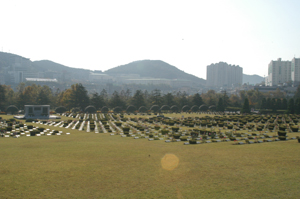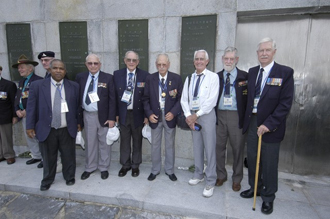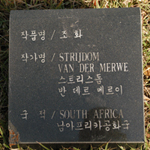| |
|
 |
The United Nations Memorial Cemetery in Korea, the final resting place of 2,300 soldiers that took part in the Korean War from 1950 - 53, is located in Busan, the southern port city of the Republic of Korea.
This cemetery occupying 14.7 hectare of land became a burial ground in April 1951. The Korean government, in order to honour the services and sacrifices given by the UN forces during the Korean War, volunteered this land for permanent use by UN as a cemetery in August 1955. |
|
From 1951 to 1954 about 11,000 soldiers were buried at this memorial cemetery but since then Belgium, Colombia, Ethiopia, Greece, Philippines and Thailand repatriated their citizens. Currently interred are 281 Australians, 378 Canadians, 44 French, 117 Dutch, 34 New Zealanders, 1 Norwegian, 36 Koreans, 11 South Africans, 462 Turkish, 885 British, 36 Americans, 4 unknown and 11 non-combatants. Each grave has an epitaph of the personí»s history. Most of the trees and shrubs found in the cemetery have been donated by various governments, organizations and individuals.
The UNMCK had been managed by the UN from March 1960. From February 1974, the Commission for the United Nations Memorial Cemetery in Korea took over the management. The Ambassador represents South Africa on the Commission. |
|
| |
|
 |
SA Korean War veterans at UN Cemetery in Busan, July 2005.
The people on the picture are from left to right: Peter Wonderlik, Brig. Gen. Albie Gotze, Lt. Gen. Mike Muller (Former Chief of the Defense Force), Brig. Gen. Jock Lello (President of the International Korean War Veterans Association), Lt. Reg. Basson, Captain Horse Sweeney and Lt. Gen. Jack Dutton.
|
|
|
|
UN Sculpture Park
The UN Sculpture Park was officially established in October 2001 as a sacred symbol of peace and freedom.
The sculpture park includes an exhibition of 29 sculpture pieces created and donated by sculptors from the 21 nations that participated in the Korean War under the UN banner. The sculptors were invited to attend the International Sculpture Symposium at the UNMCK to commemorate the 50th anniversary of the Korean War. Strijdom van der Merwe contributed his sculpture titled "Reconciliation" to this exhibition. |
|
| |
| RECONCILIATION |
Sculptor: Strijdom van der Merwe (South Africa)
|
 |
"I used a natural rock from Korea and didn't reshape it into another form, meaning that this rock can only be Korean because it was formed in Korea and found in Korea, like the Korean War. I have cut 50 lines (year rings) around the rock for the 50th anniversary of the war. You know the age of a tree by counting its year rings. This idea is used around the rock.
The gold crosses (death in the war) changes slowly over the years (over the lines) towards the top of the sculpture in to doves, meaning that the years have cured our wounds from death to peace, unification and liberty. The South African soldiers that died in the war were pilots - also the meaning for the doves (flying)."

|
|
|
|
|